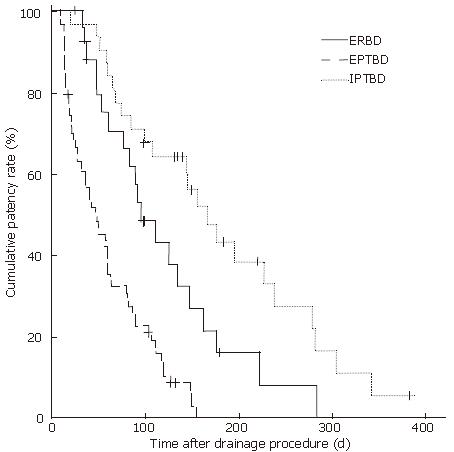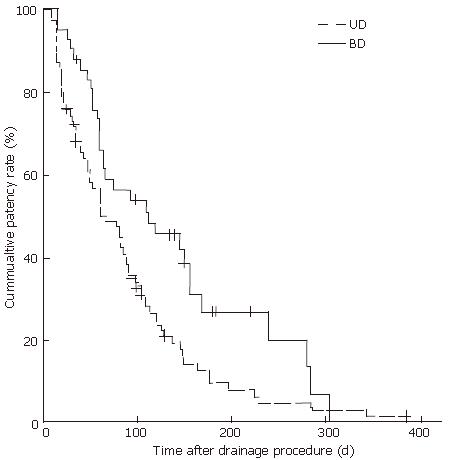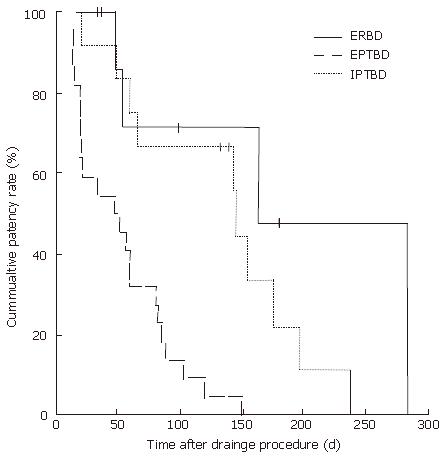Copyright
©2007 Baishideng Publishing Group Co.
World J Gastroenterol. Aug 7, 2007; 13(29): 3948-3955
Published online Aug 7, 2007. doi: 10.3748/wjg.v13.i29.3948
Published online Aug 7, 2007. doi: 10.3748/wjg.v13.i29.3948
Figure 1 Kaplan-Meier estimation of cumulative patency rates of biliary drainage according to the procedures in all Bismuth types (P = 0.
02 for ERBD vs IPTBD, P < 0.01 for ERBD vs EPTBD, P < 0.01 for IPTBD vs EPTBD). ERBD: endoscopic retrograde biliary drainage; EPTBD: external percutaneous transhepatic biliary drainage; IPTBD: internal biliary stenting via PTBD tract.
Figure 2 Comparison of cumulative patency rates of biliary drainage according to the number of stents (P = 0.
01 between BD and UD). UD: unilateral drainage; BD: bilateral drainage.
Figure 3 Kaplan-Meier estimation of cumulative patency rates for biliary drainage according to the procedures in patients with Bismuth type II Klatskin's tumor (P > 0.
05 between drainage procedures ). ERBD: endoscopic retrograde biliary drainage; EPTBD: external percutaneous transhepatic biliary drainage; IPTBD: internal biliary stenting via PTBD tract.
Figure 4 Comparison of cumulative patency rates for biliary drainage according to the procedures in patients with Bismuth type III (P = 0.
23 for ERBD vs IPTBD; P < 0.01 for ERBD vs EPTBD; P < 0.01 for IPTBD vs EPTBD). ERBD: endoscopic retrograde biliary drainage; EPTBD: external percutaneous transhepatic biliary drainage; IPTBD: internal biliary stenting via PTBD tract.
Figure 5 Cumulative patency rates for biliary drainage according to the procedures in patients with Bismuth type IV (P < 0.
01 for ERBD vs IPTBD; P = 0.06 for ERBD vs EPTBD; P < 0.01 for IPTBD vs EPTBD). ERBD: endoscopic retrograde biliary drainage; EPTBD: external percutaneous transhepatic biliary drainage; IPTBD: internal biliary stenting via PTBD tract.
- Citation: Lee SH, Park JK, Yoon WJ, Lee JK, Ryu JK, Yoon YB, Kim YT. Optimal biliary drainage for inoperable Klatskin's tumor based on Bismuth type. World J Gastroenterol 2007; 13(29): 3948-3955
- URL: https://www.wjgnet.com/1007-9327/full/v13/i29/3948.htm
- DOI: https://dx.doi.org/10.3748/wjg.v13.i29.3948













